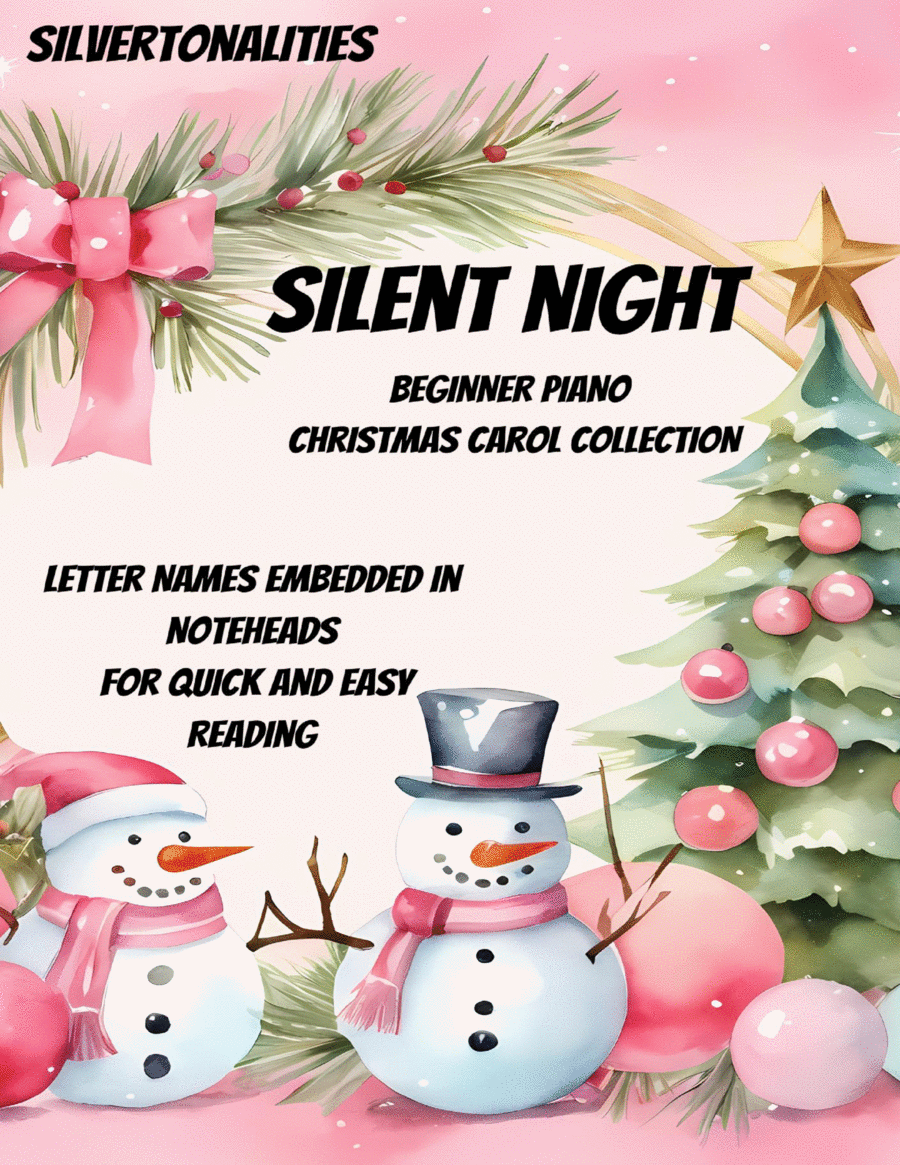Easy Piano - Level 1 - Digital Download SKU: A0.1321655 Composed by Traditional Christmas Carols. Arranged by SilverTonalities. Children,Christian,Christmas,Instructional. Score. 56 pages. SilverTonalities #910120. Published by SilverTonalities (A0.1321655). Silent Night and the Carols of Christmas for Beginner Piano Traditional Christmas Carols for Beginner Pianists by SilverTonalities!Including fingering tips and the letter names embedded into each notehead. This makes reading music a breeze, especially for beginners and allows you to quickly associate the correct notes and effortlessly recognize the pitch.ANGELS SINGING CHURCH BELLS RINGING, is a traditional Childrenâs Carol, written by Claudia Frances Hernaman, pages 1-3AWAY IN A MANGER, celebrates the birth of Jesus surrounded by gentle animals and adoring angels, Â pages 4-6BLASTS OF CHILL DECEMBER, is an English Carol composed in 1894 by Reverend R.F. Smith, with lyrics by Norval Clyne, pages 7-9CAROL OF THE BELLS, with its origins deeply rooted in the Ukraine, this instrumental Carol was composed by Mykola Leontovych in 1916, pages 10-12DECK THE HALL, is a Welsh Carol dating back to the 16th Century, representing a joyous celebration of the season, pages 13-15GOD REST YE MERRY GENTLEMEN, is a traditional English Carol, possibly dating back to as early as the 1650âs, pages 16-17GOOD KING WENCESLAS, is set to the melody of the 13th Century Spring Carol, âTempus adest floridumâ, pages 18-19HERE WE COME A WASSAILING, is a 17th Century Carol, also known as âThe Wassail Songâ, and/or âHere We Come a Caroling, pages 20-22IN BETHLEHEM CITY ON CHRISTMAS DAY MORN, is an old Worcestershire Carol, in the 7th or âLocriaenâ mode, pages 23-24JINGLE BELLS, the iconic Carol written by James Lord Pierpont in 1857 and published under the title of âOne Horse Open Sleighâ in 1857, pages 25-27JOLLY OLD ST. NICHOLAS, is a Childrenâs Christmas song, originating from a poem by Emily Huntington Miller in 1865, pages 28-30LO HOW A ROSE EVER BLOOMING, or âEs ist a Ros Entsprungenâ is a German Carol, with the lyric âRoseâ referring to the Virgin Mary, pages 31-32O COME LITTLE CHILDREN, âIhr Kinderlein kommetâ, also a German Carol composed in 1840 by Johann Abraham Peter Schulz, pages 33-34O HOLY NIGHT, or âCantique de Noelâ is a French Carol written by Adolphe C. Adam in 1843, pages 35-38PARADE OF THE WOODEN SOLDIERS, is a popular Character Piece, written by the German Composer, Leon Jessel in 1897, pages 39-43RING OUT SWEET BELLS, written by the English Composer and Organist, William Joseph Westbrook, pages 44-45SILENT NIGHT, this classic Austrian Carol was composed in 1818 by Franz Xaver Gruber, capturing the spirit of peace and harmony, pages 46-47SLOWLY FALL THE SNOWFLAKES, is a tradtional English Carol by the hymnist, William Henry Borrow, pages 48-49STAR OF THE EAST, composed by Amanda Kennedy in 1890, was inspired by the biblical story of the Star of Bethlehem leading the Wise Men to Jesus, pages 50-52WE WISH YOU A MERRY CHRISTMAS, a popular 18th Century English Carol, based on the tradition of giving treats to carolers, pages 53-54
